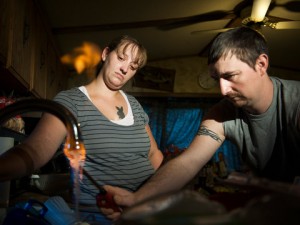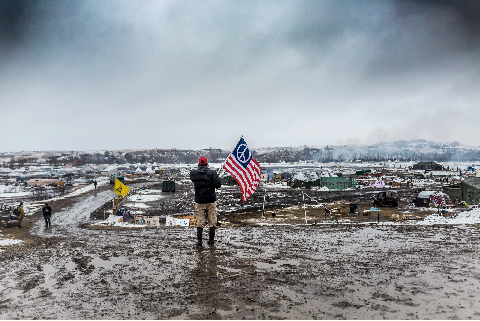PA Parks Director Says He Was Forced Out by Corbett Administration
October 12, 2012EPA Fracking Investigation in Wyoming Revisited After Objections
October 15, 2012By Jesse Newman, The New York Times, Oct. 11, 2012

The most basic thing that photography does is visually describe what can be seen. The problem facing photographers of the Marcellus Shale Documentary Project is that what they wish to describe cannot be seen — an invisible gas buried deep underground. They have struggled to document the effect of the natural gas drilling commonly known as fracking.
By now most Americans are familiar with the suggestive-sounding colloquialism; in states like Pennsylvania, which sit above shale rock formations awash in natural gas, the word resonates deeply. It is shorthand for hydraulic fracturing, and an abridged reference to the latest chapter in American resource extraction. Depending on whom you talk to, the word can signal the promise of new life (to a struggling dairy farmer, perhaps) or environmental destruction (to custodians of the state’s watershed).
For those still vague on the details of what fracking actually means, it is a process of natural gas drilling in which millions of gallons of water, sand and chemicals, some of them toxic, are pumped below ground to break up rock and release bubbles of gas stored inside. Since drilling began in the Marcellus Shale – a gas-rich rock formation that runs along the Appalachian Mountains from West Virginia to New York State – energy companies have taken vast quantities of natural gas from the earth and piped it to consumers, promoting it as clean domestic energy which can help wean America off foreign oil. In the meantime, growing complaints of water contamination around the United States have led to concerns that hydraulic fracturing poses grave risks to the health of humans and the environment.
Amid the noise on either side of the debate over drilling, members of the Marcellus Shale Documentary Project have been quietly canvassing the Pennsylvania countryside to document the people and places caught up in the state’s gas boom. Brian Cohen, the project’s director, said he liked to think of the group as something like a modern-day Farm Security Administration. Together, the six photographers have been able to do what no one of them could do alone: crisscross the state, photograph dozens of drill rigs that have popped up along highways and in backyards, and talk to farmers, homeowners, drillers, environmental advocates and lawyers, all of whom have a profound stake in the invisible substance buried more than a mile below ground. Ultimately, their aim is to create a visual record of the “great shale rush,” and chronicle the changes that Americans can expect to see as we drill our way into the future.
The group’s photographs depict a heavy industrial process scattered across a rural landscape: amid miles of lush green forest or farmland, suddenly there is a shaved patch. Atop the clearing is a battery of drilling equipment: a tall derrick, bright klieg lights and lined troughs full of chemical wastewater. In some photographs, a long, steel pipeline snakes through the frame. In others, the flare from a drill rig lights the night sky. There are pictures of people, too: farmers who leased their land for drilling, homeowners with enough methane in their groundwater to light a tap on fire; and here and there, an industry employee.
Because of its scope, the Marcellus Shale Documentary Project offers an in-depth look at the transformations taking place across rural Pennsylvania, where thousands of wells have been drilled in recent years, and more are planned. To be sure, photographers said, the shale gas boom has provided a jolt to the local economy of struggling towns, and many residents are benefiting — directly or indirectly — from the new income and business. But there are environmental hazards, of course, and residents are also coping with the unexpected side effects of rapid industrialization. Downtown streets are choked with traffic, local services are straining to accommodate thousands of workers who have arrived from out of state, and the influx of drillers has created housing crises in some places. There are rifts between residents with different views on fracking, and tension between locals and drillers, who hail largely from states in the South.
Each of the photographers — Mr. Cohen, Noah Addis, Nina Berman, Scott Goldsmith, Lynn Johnson and Martha Rial — brings a distinct style and sensibility to the issue of natural gas drilling. Many of Mr. Cohen’s photographs, for example, are panoramic landscapes in which the drill rigs tend to be small. Their diminutive size is paradoxical, of course, given the immensity of the work they do, and their potential impact on American energy, the economy and the surrounding ecosystem.
As Mr. Cohen explained, “It’s hard to figure out how to communicate that there is something going on that could have repercussions but that doesn’t seem, on the surface, to be having much of an imprint.”
A similar artistic challenge motivated Ms. Berman, who said she was drawn to projects that stir up contradictory feelings. Driving around northeastern Pennsylvania, especially at night, she felt both spooked by and attracted to the landscape. “The place took on a different feel that was simultaneously very creepy and seductive,” Ms. Berman said. Over time, she began to see her divergent reactions as a metaphor for the entire project of shale gas drilling. On one hand, there is the lure of fast, easy money, she said. On the other, is the darker side, the contamination of Pennsylvania’s aquifers.
“I want people to consider that feeling,” Ms. Berman said. “The feeling of being seduced by something that may not necessarily be in your best interest. Or may be in your best interest, it depends.”
For her part, Ms. Johnson used two different visual styles to make two separate sets of pictures. Her black and white photographs, shot in traditional photojournalistic style, focus on the daily lives of residents and environmental activists. But as she traveled across Pennsylvania, Ms. Johnson also began taking pictures with her iPhone. The result is a series of small photographs that are colorful, electric and spur of the moment. Viewed in quick succession, they seem like simple sketches, or impressions, of a complex time and place.
According to Ms. Johnson, one of the most troubling aspects of the controversy over natural gas drilling is how it has torn at the social fabric of small communities. It is not just a question of toxicity in the land, she said, but of poisoned personal relationships. “The presence of drilling corrupts everyone on both sides,” Ms. Johnson said. “It has drawn battle lines in communities. Families are pitted against families, neighbor against neighbor, mother against son.” But allies have been created of people who might otherwise have had little in common.
The thing about hydraulic fracturing, said members of the Marcellus Shale Documentary Project, is that even after you make sense of its complex science and divisive politics, it still isn’t easy to photograph. First, there is the invisibility of the stuff itself. “We’re talking about things like air and water,” Mr. Cohen said. “These are the two central issues in this story, and they’re very ethereal and hard to grasp.”
Second, there is the issue of access, to the gas industry and homeowners who have assented — or declined — to lease land to the companies. In an effort to portray the process fairly, Mr. Cohen said, photographers in the group repeatedly sought cooperation from drilling companies. “We’ve made a tremendous effort not to be purely ideological about it,” he said. “But we’ve gotten almost nothing back. It’s been like banging our heads against the wall.”
People whose water supply has been contaminated are more readily available, Mr. Cohen said, but even they can fear being photographed. “A lot of people are very shy of being exposed,” he said. “There’s a lot of stuff that doesn’t make it onto camera because people are frightened. They are very, very intimidated.”
Many people who have challenged a gas company in court are prohibited from speaking to the media via nondisclosure agreements, Ms. Berman said. In other cases, it can be difficult to verify the facts when someone claims their well water has gone bad. But Ms. Berman said she thought the dearth of compelling photographs about hydraulic fracturing went beyond the question of access. Environmental issues can be difficult subject matter for photojournalists, she said. “It can be hard to get into a landscape if you’re used to photographing people and very active situations.”
What’s more, many activists post their own pictures online, which Ms. Berman said could sometimes deter professionals. Finally, the recent documentary film “Gasland” had a big effect on the still images that followed it. Many photographers thought the picture to get was the exploding faucet, she said. They thought this is a story “with gotcha pictures.” But the drill rigs, pipelines and faucets on fire are only part of the story, Mr. Cohen said. Visually, they are compelling, important pictures. “But that’s the sensational stuff,” he said. “Once you get past that, there are real things that are happening to real people, that, if you focus merely on the stuff, you are going to miss.”
Despite the challenges, photographs taken by the Marcellus Shale Documentary Project make up an absorbing account of the drilling frenzy in America. Looking at them, it is hard not to recall the last energy boom in Pennsylvania, when anthracite coal mines collected near the Susquehanna River. No doubt things have changed in the past century; today there are brine pits instead of culm banks and gas compressor stations in lieu of coal breakers. River barges and trains are also a thing of the past; these days, tanker trucks marked “residual waste” tear up and down winding two-lane highways instead.
Any number of these highways will take you to Pittsburgh, where an exhibition of the Marcellus Shale Documentary Project’s photographs opens Thursday night at Pittsburgh Filmmakers Galleries. Just please be careful driving.



